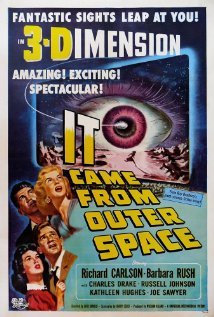Does every SF movie made in the 1950s have to be an analog of McCarthyism? This is nothing more than a good SF movie made with a certain elan by Jack Arnold on a low budget. The desert, alas, is supposed to be in Arizona, which means that it should be Sonoran, with saguaro cacti. Instead it is clearly Mohave desert with its signature plant, the Joshua tree. The lizard at the beginning is right, though, a desert night lizard that looks like Xanthusia arizonae. Everyone plays his or her part with competence. There is no way in such a movie that any performance could be anything more than that. Now and again a car or truck pulls off the road and parks in an empty spot in the desert. Appealing images. The empty spaces are rapidly being filled with condominiums that use water taken from neighboring farmers. Joe McCarthy isn’t looking over our shoulders. Some real estate developer is.
Enough preaching. This is one of the better low-budget SF films to appear in the 1950s, oddly similar to, but far less complex than, “Invasion of the Body Snatchers.” Universal Studios ground out a number of these profitable little enterprises and Richard Carlson was in several of them. That’s as it should be, because Richard Carlson has the blandly believable face of Everyman, a kind of Humphrey C. Earwicker of B films. In this particular movie, Barbara Rush is a magnetic presence. Her performance may be limited to worried frowns and frightened screams but she looks perfectly consumable with her tight skirts and impudent bosom. It’s understandable that the aliens should want to engulf her in jelly and smoke. Charles Drake is the irritable, unbelieving sheriff, jealous of Carlson’s bond with Rush. Less use is made of Dr. Snell, the professional astronomer, who is seen only once as another doubting Thomas. The scientific expert who is called in to consult on the case is a stock figure in these scenarios. So is the Army general who wants to bomb everything into submission, but his place is taken here by Drake’s sheriff who organizes an armed mob to exterminate the undocumented aliens. Ray Bradbury’s dialog has some musings on the mysteries of that rapidly disappearing desert. The dialog during the “wind in the wires” scene is his. (The music is by Henry Mancini.) So is some of the dialog by the two miners who compare the aging tunnel to an old man — both need propping up. These add to the eerie sense of the unknown. That, it appears, was the central moral message of the film. What we don’t understand, we fear. And what we fear, we kill.

